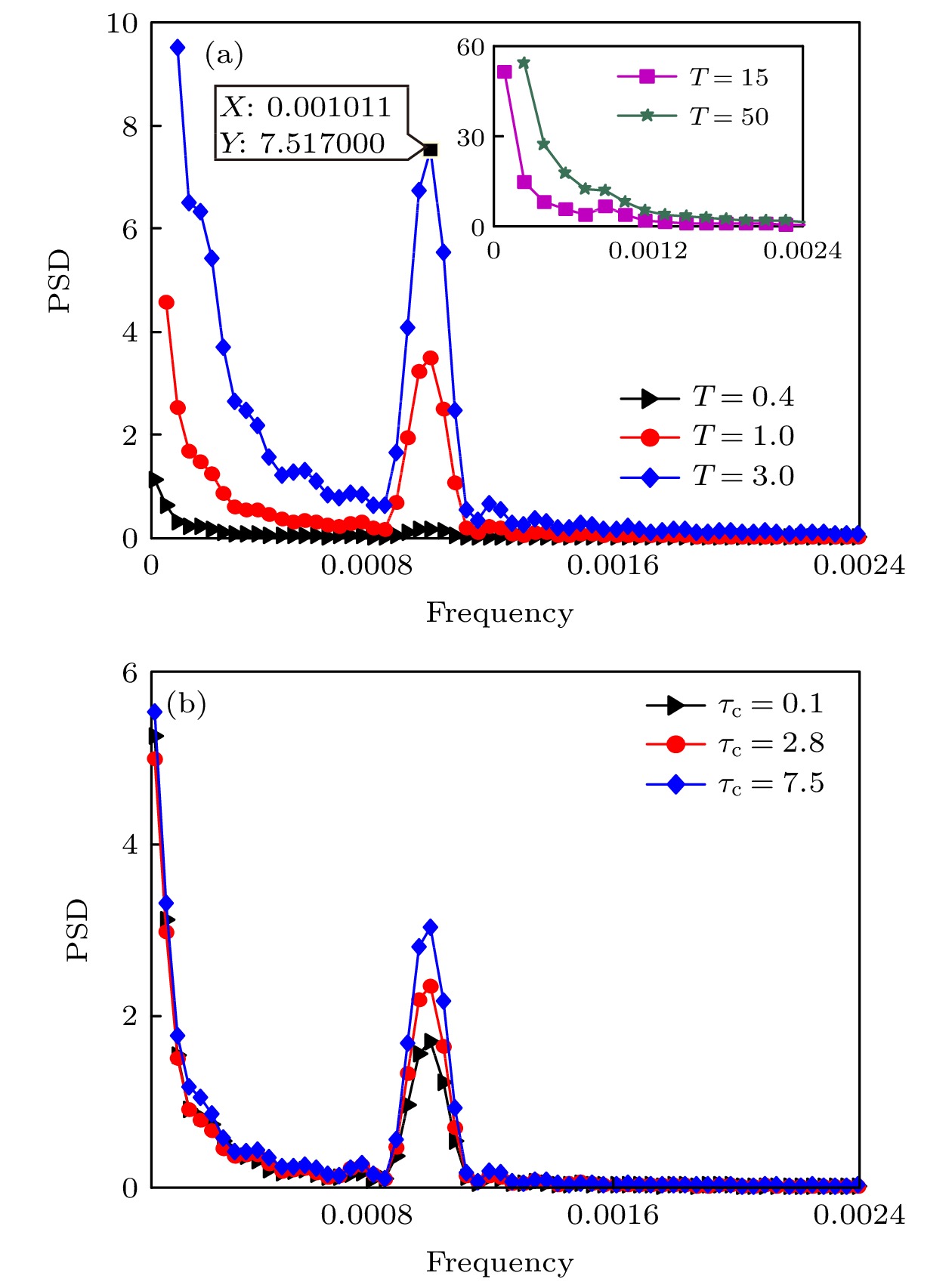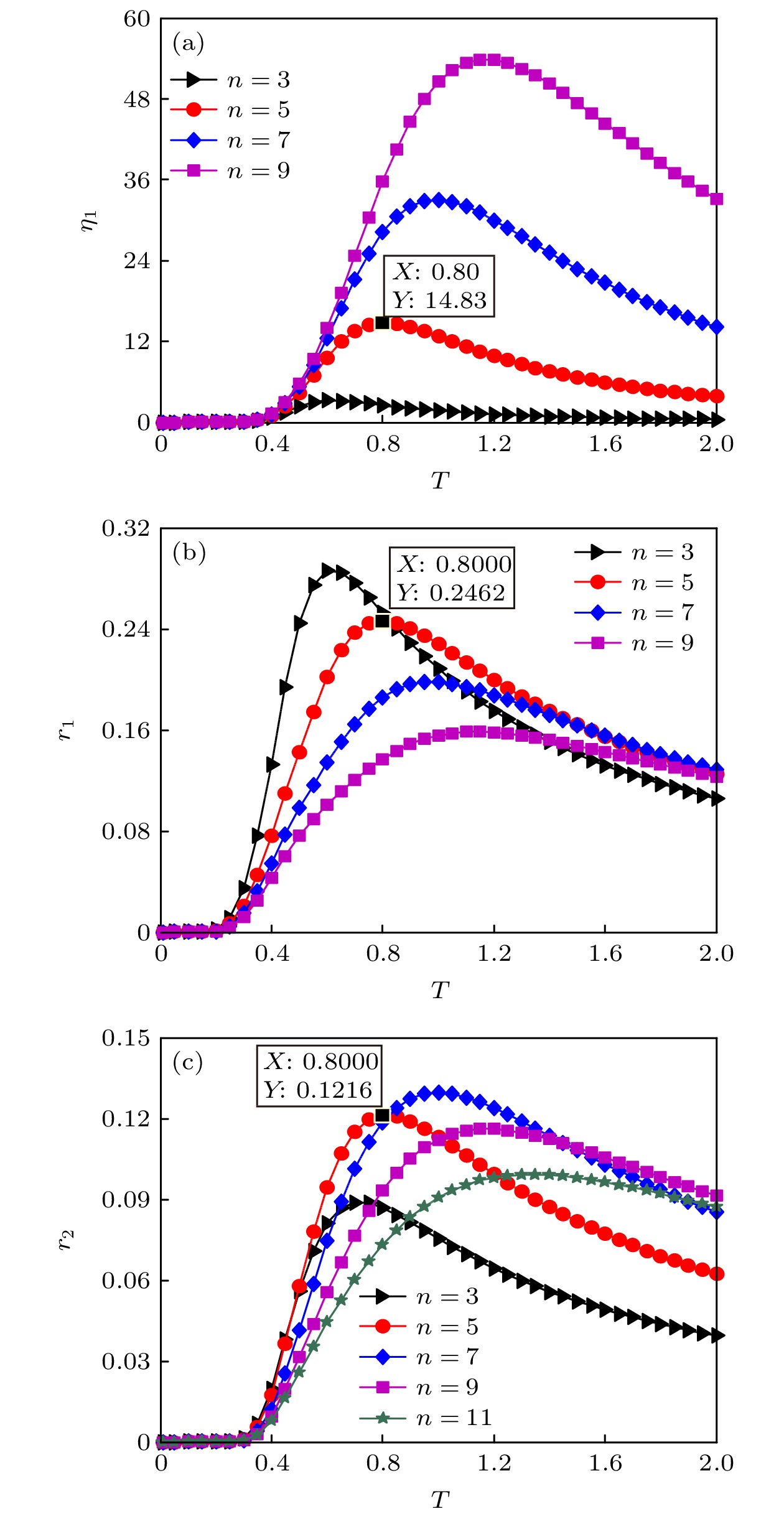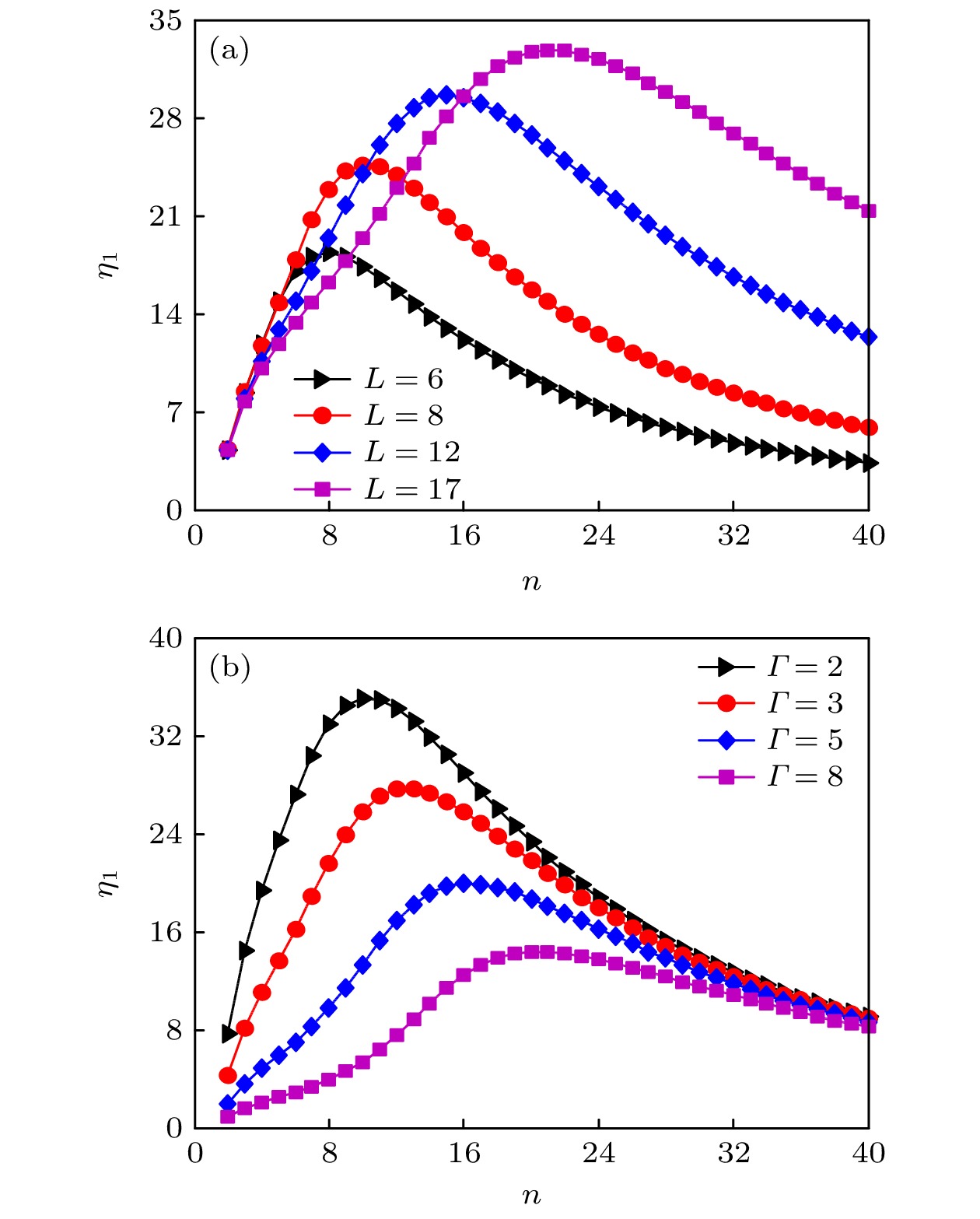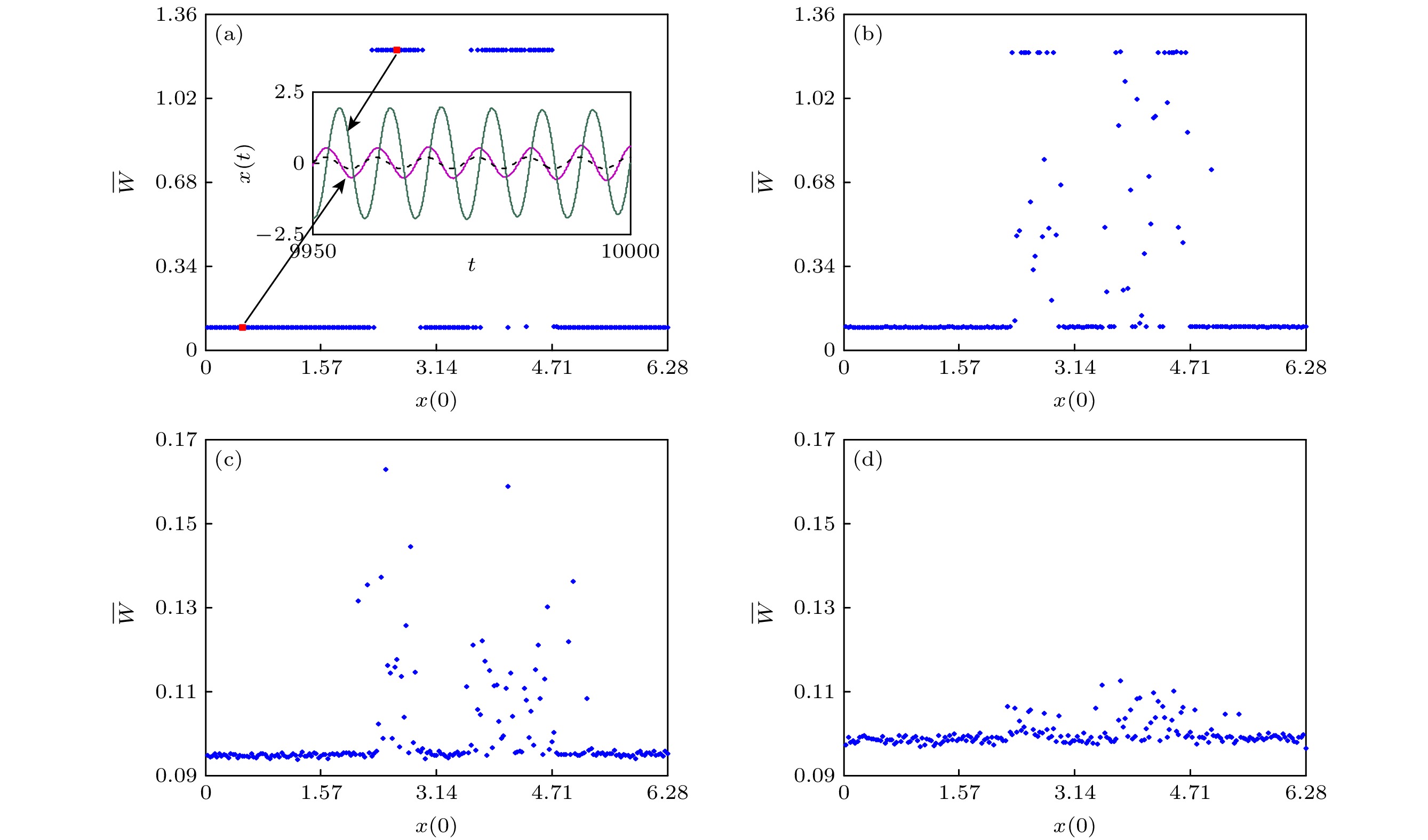-
研究了外部周期信号和内部噪声共同激励下, 含记忆阻尼函数的周期势系统的随机共振. 针对具有多稳态特征的周期势系统, 推导出适用于一般多稳态模型的系统响应振幅和功率谱放大因子. 研究结果表明, 功率谱放大因子随温度的变化曲线出现单峰, 说明含记忆阻尼函数的周期势系统存在随机共振现象, 并且系统的记忆特性和稳态点数量对共振行为有着显著影响. 此外, 利用随机能量法进一步分析了系统的随机共振现象, 发现共振效应随着记忆时间的增加先减弱再增强. 在适当的温度条件下, 存在最优记忆时间可以最大化外部周期力对系统所做的功.
-
关键词:
- 随机共振 /
- 周期势系统 /
- 广义Langevin方程
The stochastic dynamical system with memory effects describes a non-Markovian process that can happen in some complex systems or disordered media, such as viscoelastic media and living cell. Its velocity yields the memory effects because of the nonlocality in time, giving rise to a generalized Langevin equation for describing the dynamics of the system. In particular, the friction term in generalized Langevin equation is given by the time-dependent memory kernel. Besides, the research of stochastic resonance in periodic potential models emerges as an important subject because such systems have potential applications in diverse areas of natural sciences. However, the analysis of the influence of memory on stochastic resonance has not been reported so far in periodic potential model. In this paper, the phenomenon of stochastic resonance is investigated in the periodic potential system with friction memory kernel driven by an external periodic signal and internal noise. The generalized Langevin equation is converted into the three-dimensional Markovian Langevin equations. Analytical expression for the spectral amplification, together with the amplitude of the response, is derived in the periodic potential with an arbitrary number of simultaneously stable steady states, which can be applied to the general multi-stable dynamical model. The obtained results indicate that the curve of spectral amplification versus temperature exhibits a pronounced peak. Obviously, this typical phenomenon is a signature of stochastic resonance. The stochastic resonance effect is enhanced with the increase of the memory time or the number of stable steady states. For a certain range of the particle motion, the existence of an optimal number of stable steady states for which the output of the system can be maximized is established. Moreover, the phenomenon of stochastic resonance is studied according to the stochastic energetics. The average input energy per period is calculated over all the trajectories for quantifying stochastic resonance. It is found that the stochastic resonance effect is first weakened and then enhanced with increasing memory time. Specifically, under appropriate temperature conditions, there is an optimal memory time, which can maximize the work done by the external periodic force on the system.[1] Benzi R, Sutera A, Vulpiani A 1981 J. Phys. A 14 L453
 Google Scholar
Google Scholar
[2] Gammaitoni L, Hänggi P, Jung P, Marchesoni F 1998 Rev. Mod. Phys. 70 223
 Google Scholar
Google Scholar
[3] Nicolis C 2010 Phys. Rev. E 82 011139
 Google Scholar
Google Scholar
[4] Qiao Z J, Lei Y G, Li N P 2019 Mech. Syst. Sig. Process. 122 502
 Google Scholar
Google Scholar
[5] Goychuk I, Pöschel T 2020 New J. Phys. 22 113018
 Google Scholar
Google Scholar
[6] Mokshin A V, Yulmetyev R M, Hänggi P 2005 Phys. Rev. Lett. 95 200601
 Google Scholar
Google Scholar
[7] Despósito M A, Pallavicini C, Levi V, Bruno L 2011 Physica A 390 1026
 Google Scholar
Google Scholar
[8] Tolić-Nørrelykke I M, Munteanu E L, Thon G, Oddershede L, Berg-Sørensen K 2004 Phys. Rev. Lett. 93 078102
 Google Scholar
Google Scholar
[9] Viñales A D, Despósito M A 2006 Phys. Rev. E 73 016111
 Google Scholar
Google Scholar
[10] Bao J D, Zhuo Y Z 2003 Phys. Rev. Lett. 91 138104
 Google Scholar
Google Scholar
[11] Goychuk I 2010 Chem. Phys. 375 450
 Google Scholar
Google Scholar
[12] Wang K G, Masoliver J 1996 Physica A 231 615
 Google Scholar
Google Scholar
[13] Xu P F, Jin Y F 2020 Chaos, Solitons & Fractals 138 109857
 Google Scholar
Google Scholar
[14] Kumar N 2012 Phys. Rev. E 85 011114
 Google Scholar
Google Scholar
[15] Kubo R, Toda M, Hashitsume N 1985 Statistical Physics II: Non-equilibrium Statistical Mechanics (Berlin: Springer-Verlag) p31
[16] Goswami G, Mukherjee B, Bag B C 2005 Chem. Phys. 312 47
 Google Scholar
Google Scholar
[17] Hohenegger C, Durr R, Senter D M 2017 J. Non-Newton. Fluid 242 48
 Google Scholar
Google Scholar
[18] Zhong S C, Zhang L, Wang H Q, Ma H, Luo M K 2017 Nonlinear Dyn. 89 1327
 Google Scholar
Google Scholar
[19] 谢文贤, 李东平, 许鹏飞, 蔡力, 靳艳飞 2014 物理学报 63 100502
 Google Scholar
Google Scholar
Xie W X, Li D P, Xu P F, Cai L, Jin Y F 2014 Acta Phys. Sin. 63 100502
 Google Scholar
Google Scholar
[20] He G T, Guo D L, Tian Y, Li T J, Luo M K 2017 Physica A 484 91
 Google Scholar
Google Scholar
[21] Hasegawa H 2013 Physica A 392 2532
 Google Scholar
Google Scholar
[22] Srokowski T 2013 Eur. Phys. J. B 86 239
 Google Scholar
Google Scholar
[23] Coffey W T, Kalmykov Y P, Massawe E S 1993 Phys. Rev. E 48 77
 Google Scholar
Google Scholar
[24] Elston T C, Peskin C S 2000 SIAM J. Appl. Math. 60 842
 Google Scholar
Google Scholar
[25] Hänggi P, Bartussek R, Talkner P, Łuczka J 1996 Europhys. Lett. 35 315
 Google Scholar
Google Scholar
[26] Reenbohn W L, Mahato M C 2015 Phys. Rev. E 91 052151
 Google Scholar
Google Scholar
[27] Li J H 2010 J. Phys. Condens. Mater. 22 115702
 Google Scholar
Google Scholar
[28] Jin Y F, Ma Z M, Xiao S M 2017 Chaos, Solitons & Fractals 103 470
 Google Scholar
Google Scholar
[29] Saikia S 2014 Physica A 416 411
 Google Scholar
Google Scholar
[30] Reenbohn W L, Pohlong S S, Mahato M C 2012 Phys. Rev. E 85 031144
 Google Scholar
Google Scholar
[31] 谢勇, 刘若男 2017 物理学报 66 120501
 Google Scholar
Google Scholar
Xie Y, Liu R N 2017 Acta Phys. Sin. 66 120501
 Google Scholar
Google Scholar
[32] Sawkmie I S, Mahato M C 2019 Commun. Nonlinear Sci. Numer. Simul. 78 104859
 Google Scholar
Google Scholar
[33] Liu R N, Kang Y M 2018 Phys. Lett. A 382 1656
 Google Scholar
Google Scholar
[34] Liu K H, Jin Y F 2013 Physica A 392 5283
 Google Scholar
Google Scholar
[35] Neiman A, Sung W 1996 Phys. Lett. A 223 341
 Google Scholar
Google Scholar
[36] Bao J D, Bai Z W 2005 Chin. Phys. Lett. 22 1845
 Google Scholar
Google Scholar
[37] 康艳梅, 徐健学, 谢勇 2003 物理学报 52 802
 Google Scholar
Google Scholar
Kang Y M, Xu J X, Xie Y 2003 Acta Phys. Sin. 52 802
 Google Scholar
Google Scholar
[38] Nicolis C 2012 Phys. Rev. E 86 011133
 Google Scholar
Google Scholar
[39] Dykman M I, Haken H, Hu G, Luchinsky D G, Mannella R, Mcclintock P V E, Ning C Z, Stein N D, Stocks N G 1993 Phys. Lett. A 180 332
 Google Scholar
Google Scholar
[40] Jin Y F 2012 Physica A 391 1928
 Google Scholar
Google Scholar
-
图 2 记忆时间
$ {\tau _c} $ 对随机共振的影响 (a) 功率谱放大因子$ {\eta _1} $ 随温度T的变化曲线($ n = 6 $ ); (b)第i个稳态点对应的响应振幅$ {r_i} $ 的变化曲线. 其他参数取值为$\varGamma = 4$ ,${\gamma _0} = $ $ 1$ ,$ \omega = 0.001 $ 和$ {m_0} = 1 $ Fig. 2. The effects of memory time
$ {\tau _c} $ on stochastic resonance: (a) Spectral amplification$ {\eta _1} $ versus temperature T; (b) amplitude of the response$ {r_i} $ versus i. Other parameter values are chosen as$\varGamma = 4$ ,$ {\gamma _0} = 1 $ ,$ \omega = 0.001 $ and$ {m_0} = 1 $ .图 3 功率谱密度(PSD)作为频率的函数曲线 (a)不同的温度T和
$ {\tau _c} = 1 $ ; (b)不同的记忆时间$ {\tau _c} $ 和$ T = 0.75 $ . 其他参数取值为$\varGamma = 4$ ,$ {\gamma _0} = 1 $ ,$ {\varepsilon _0} = 0.3 $ ,$ \omega = 0.001 $ 和$ {m_0} = 1 $ Fig. 3. Power spectrum density (PSD) of the system as a function of frequency with different values of (a) temperature T (
$ {\tau _c} = 1 $ ); (b) memory time$ {\tau _c} $ ($ T = 0.75 $ ). Other parameter values are chosen as$\varGamma = 4$ ,$ {\gamma _0} = 1 $ ,$ {\varepsilon _0} = 0.3 $ ,$ \omega = 0.001 $ and$ {m_0} = 1 $ .图 4 稳态点个数n对随机共振的影响 (a)功率谱放大因子
$ {\eta _1} $ 随温度T的变化曲线; (b)响应振幅$ {r_1} $ 随T的变化曲线; (c)响应振幅$ {r_2} $ 随T的变化曲线. 其他参数取值为$ {\tau _c} = 3 $ ,$\varGamma = 5$ ,$ {\gamma _0} = 1 $ ,$ \omega = 0.001 $ 和$ {m_0} = 1 $ Fig. 4. The effects of the number of stable steady states n on stochastic resonance: (a) Spectral amplification
$ {\eta _1} $ versus temperature T; (b) amplitude of the response$ {r_1} $ versus T; (c) amplitude of the response$ {r_2} $ versus T. Other parameter values are chosen as$ {\tau _c} = 3 $ ,$\varGamma = 5$ ,$ {\gamma _0} = 1 $ ,$ \omega = 0.001 $ and$ {m_0} = 1 $ .图 5 功率谱放大因子
$ {\eta _1} $ 作为区间内稳态点个数n的函数曲线 (a)不同的区间长度L和$\varGamma = 3$ ; (b)不同的记忆强度Γ和固定的长度$ L = 10 $ . 其他参数取值为$ {\tau _c} = 4 $ ,${\gamma _0} = $ $ 1$ ,$ \omega = 0.002 $ 和$ T = 0.8 $ Fig. 5. Spectral amplification
$ {\eta _1} $ versus the number of stable steady states n with different values of (a) interval length L ($\varGamma = 3$ ) and (b) memory strength Γ ($ L = 10 $ ). Other parameter values are chosen as$ {\tau _c} = 4 $ ,$ {\gamma _0} = 1 $ ,$ \omega = 0.002 $ and$ T = 0.8 $ .图 6 平均输入能量
$ \overline W $ 作为初始位置$ x(0) $ 的函数随不同温度T的变化情况, 黑色线代表系统的输入信号$ {\varepsilon _0}\cos (\omega t) $ (a) T = 0.001; (b) T = 0.003; (c) T = 0.009; (d) T = 0.018. 其他参数取值为$ {\tau _c} = 2.3 $ ,$ {\gamma _0} = 0.12 $ ,$\varGamma = 0.02$ 和$ \omega = {\pi {\left/ {\vphantom {\pi 4}} \right.} 4} $ Fig. 6. Average input energy
$ \overline W $ averaged over an entire trajectory with initial position$ x(0) $ for different values of temperature T, where the black line denotes the input signal$ {\varepsilon _0}\cos (\omega t) $ : (a) T = 0.001; (b) T = 0.003; (c) T = 0.009; (d) T = 0.018. Other parameter values are chosen as$ {\tau _c} = 2.3 $ ,$ {\gamma _0} = 0.12 $ ,$\varGamma = 0.02$ and$ \omega = {\pi {\left/ {\vphantom {\pi 4}} \right. } 4} $ .图 7 记忆强度Γ对输入能量的影响 (a)平均输入能量
$ \left\langle {\overline W } \right\rangle $ 随温度T的变化曲线; (b)相位差$\overline \varPhi$ 随T的变化曲线. 其他参数取值为$ {\tau _c} = 2.3 $ ,$ {\gamma _0} = 0.12 $ 和$ \omega = {\pi {\left/ {\vphantom {\pi 4}} \right. } 4} $ Fig. 7. The effects of memory strength Γ on input energy: (a) Average input energy
$ \left\langle {\overline W } \right\rangle $ versus temperature T; (b) phase lag$\overline \varPhi$ versus T. Other parameter values are chosen as$ {\tau _c} = 2.3 $ ,$ {\gamma _0} = 0.12 $ and$ \omega = {\pi {\left/ {\vphantom {\pi 4}} \right. } 4} $ .图 8 记忆时间
$ {\tau _c} $ 对输入能量的影响 (a)$ \left\langle {\overline W } \right\rangle $ 随T的变化曲线; (b)$ \left\langle {\overline W } \right\rangle $ 随$ {\tau _c} $ 的变化曲线. 其他参数取值为$ \varGamma = 0.7 $ ,$ {\gamma _0} = 0.12 $ 和$ \omega = {\pi {\left/ {\vphantom {\pi 4}} \right. } 4} $ Fig. 8. The effects of memory time
$ {\tau _{\rm{c}}} $ on input energy: (a)$ \left\langle {\overline W } \right\rangle $ versus T; (b)$ \left\langle {\overline W } \right\rangle $ versus$ {\tau _c} $ . Other parameter values are chosen as$\varGamma = 0.7$ ,$ {\gamma _0} = 0.12 $ and$ \omega = {\pi {\left/ {\vphantom {\pi 4}} \right. } 4} $ . -
[1] Benzi R, Sutera A, Vulpiani A 1981 J. Phys. A 14 L453
 Google Scholar
Google Scholar
[2] Gammaitoni L, Hänggi P, Jung P, Marchesoni F 1998 Rev. Mod. Phys. 70 223
 Google Scholar
Google Scholar
[3] Nicolis C 2010 Phys. Rev. E 82 011139
 Google Scholar
Google Scholar
[4] Qiao Z J, Lei Y G, Li N P 2019 Mech. Syst. Sig. Process. 122 502
 Google Scholar
Google Scholar
[5] Goychuk I, Pöschel T 2020 New J. Phys. 22 113018
 Google Scholar
Google Scholar
[6] Mokshin A V, Yulmetyev R M, Hänggi P 2005 Phys. Rev. Lett. 95 200601
 Google Scholar
Google Scholar
[7] Despósito M A, Pallavicini C, Levi V, Bruno L 2011 Physica A 390 1026
 Google Scholar
Google Scholar
[8] Tolić-Nørrelykke I M, Munteanu E L, Thon G, Oddershede L, Berg-Sørensen K 2004 Phys. Rev. Lett. 93 078102
 Google Scholar
Google Scholar
[9] Viñales A D, Despósito M A 2006 Phys. Rev. E 73 016111
 Google Scholar
Google Scholar
[10] Bao J D, Zhuo Y Z 2003 Phys. Rev. Lett. 91 138104
 Google Scholar
Google Scholar
[11] Goychuk I 2010 Chem. Phys. 375 450
 Google Scholar
Google Scholar
[12] Wang K G, Masoliver J 1996 Physica A 231 615
 Google Scholar
Google Scholar
[13] Xu P F, Jin Y F 2020 Chaos, Solitons & Fractals 138 109857
 Google Scholar
Google Scholar
[14] Kumar N 2012 Phys. Rev. E 85 011114
 Google Scholar
Google Scholar
[15] Kubo R, Toda M, Hashitsume N 1985 Statistical Physics II: Non-equilibrium Statistical Mechanics (Berlin: Springer-Verlag) p31
[16] Goswami G, Mukherjee B, Bag B C 2005 Chem. Phys. 312 47
 Google Scholar
Google Scholar
[17] Hohenegger C, Durr R, Senter D M 2017 J. Non-Newton. Fluid 242 48
 Google Scholar
Google Scholar
[18] Zhong S C, Zhang L, Wang H Q, Ma H, Luo M K 2017 Nonlinear Dyn. 89 1327
 Google Scholar
Google Scholar
[19] 谢文贤, 李东平, 许鹏飞, 蔡力, 靳艳飞 2014 物理学报 63 100502
 Google Scholar
Google Scholar
Xie W X, Li D P, Xu P F, Cai L, Jin Y F 2014 Acta Phys. Sin. 63 100502
 Google Scholar
Google Scholar
[20] He G T, Guo D L, Tian Y, Li T J, Luo M K 2017 Physica A 484 91
 Google Scholar
Google Scholar
[21] Hasegawa H 2013 Physica A 392 2532
 Google Scholar
Google Scholar
[22] Srokowski T 2013 Eur. Phys. J. B 86 239
 Google Scholar
Google Scholar
[23] Coffey W T, Kalmykov Y P, Massawe E S 1993 Phys. Rev. E 48 77
 Google Scholar
Google Scholar
[24] Elston T C, Peskin C S 2000 SIAM J. Appl. Math. 60 842
 Google Scholar
Google Scholar
[25] Hänggi P, Bartussek R, Talkner P, Łuczka J 1996 Europhys. Lett. 35 315
 Google Scholar
Google Scholar
[26] Reenbohn W L, Mahato M C 2015 Phys. Rev. E 91 052151
 Google Scholar
Google Scholar
[27] Li J H 2010 J. Phys. Condens. Mater. 22 115702
 Google Scholar
Google Scholar
[28] Jin Y F, Ma Z M, Xiao S M 2017 Chaos, Solitons & Fractals 103 470
 Google Scholar
Google Scholar
[29] Saikia S 2014 Physica A 416 411
 Google Scholar
Google Scholar
[30] Reenbohn W L, Pohlong S S, Mahato M C 2012 Phys. Rev. E 85 031144
 Google Scholar
Google Scholar
[31] 谢勇, 刘若男 2017 物理学报 66 120501
 Google Scholar
Google Scholar
Xie Y, Liu R N 2017 Acta Phys. Sin. 66 120501
 Google Scholar
Google Scholar
[32] Sawkmie I S, Mahato M C 2019 Commun. Nonlinear Sci. Numer. Simul. 78 104859
 Google Scholar
Google Scholar
[33] Liu R N, Kang Y M 2018 Phys. Lett. A 382 1656
 Google Scholar
Google Scholar
[34] Liu K H, Jin Y F 2013 Physica A 392 5283
 Google Scholar
Google Scholar
[35] Neiman A, Sung W 1996 Phys. Lett. A 223 341
 Google Scholar
Google Scholar
[36] Bao J D, Bai Z W 2005 Chin. Phys. Lett. 22 1845
 Google Scholar
Google Scholar
[37] 康艳梅, 徐健学, 谢勇 2003 物理学报 52 802
 Google Scholar
Google Scholar
Kang Y M, Xu J X, Xie Y 2003 Acta Phys. Sin. 52 802
 Google Scholar
Google Scholar
[38] Nicolis C 2012 Phys. Rev. E 86 011133
 Google Scholar
Google Scholar
[39] Dykman M I, Haken H, Hu G, Luchinsky D G, Mannella R, Mcclintock P V E, Ning C Z, Stein N D, Stocks N G 1993 Phys. Lett. A 180 332
 Google Scholar
Google Scholar
[40] Jin Y F 2012 Physica A 391 1928
 Google Scholar
Google Scholar
计量
- 文章访问数: 8420
- PDF下载量: 149
- 被引次数: 0













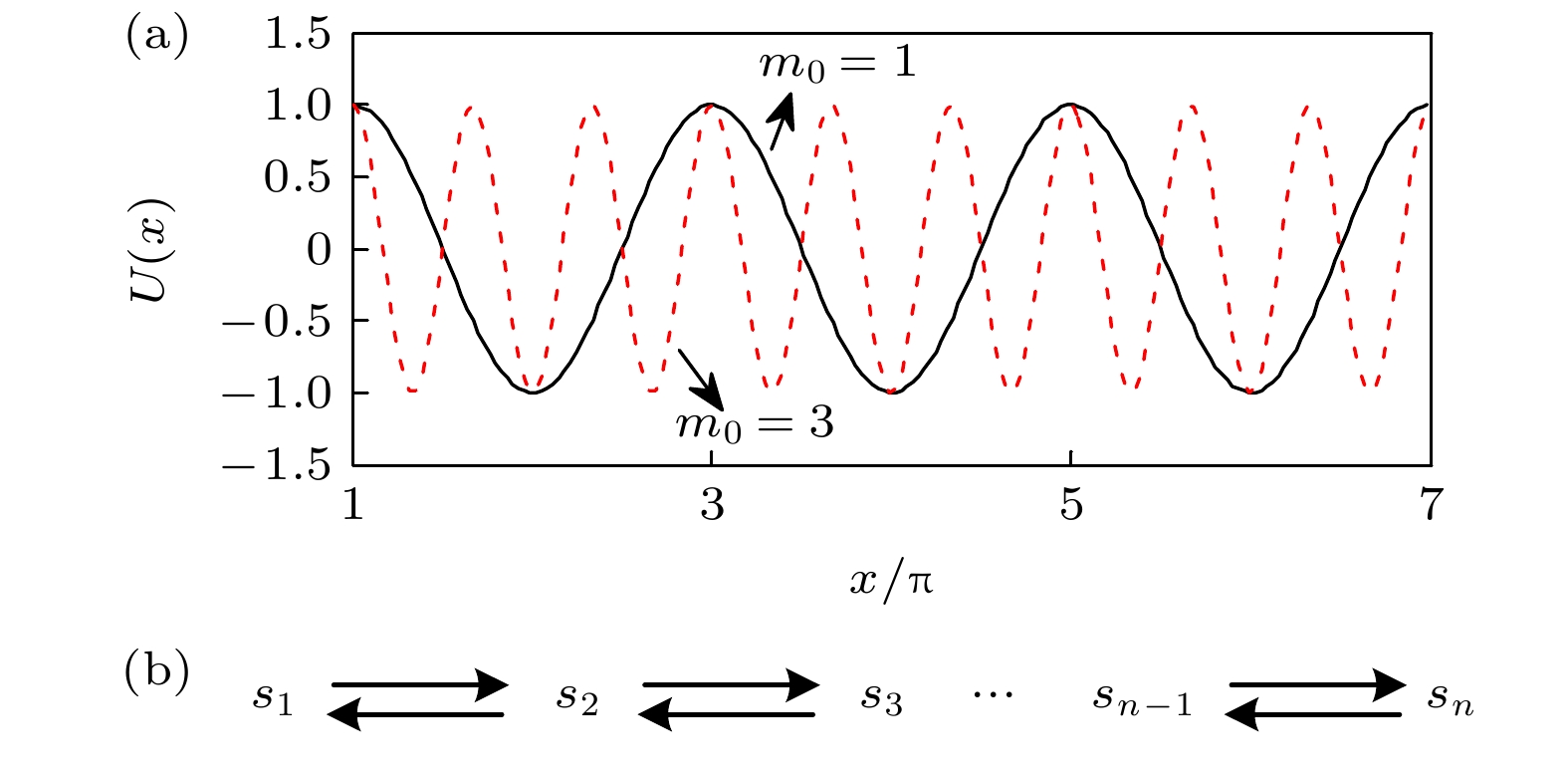
 下载:
下载:

















